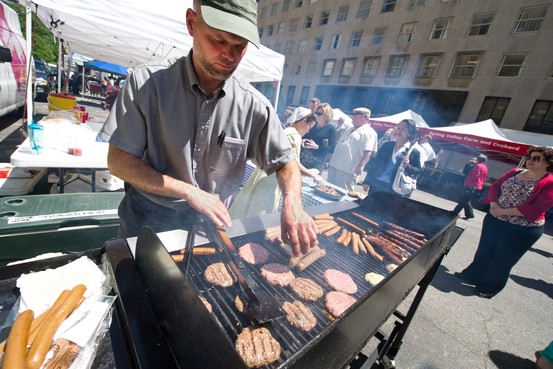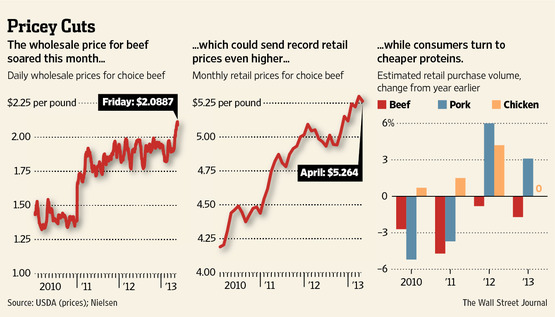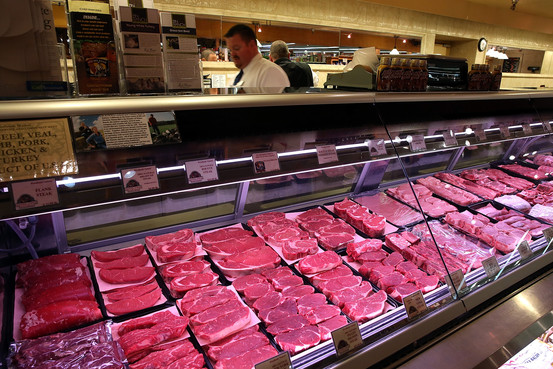Corky
is one Smokin' Farker
- Joined
- Jun 21, 2011
- Location
- Liberty...
http://online.wsj.com/article/SB100...3222935782726.html?mod=WSJ_hpp_LEFTTopStories
Pricey Beef Puts Heat on U.S. Grilling Season
By KELSEY GEE, IAN BERRY and CURT THACKER
As Americans prepare for Memorial Day—the official kickoff to a summer grilling season of burgers and T-bones—rising beef prices have some consumers balking in the grocery aisles.
Retail beef prices are widely expected to set new records in coming weeks after wholesale prices, or the amount meatpackers charge sellers for beef, hit an all-time peak this past week.

AFP/Getty Images Kinley Coulter, owner of Colter Farms, grills homemade sausages and beef patties in Washington, D.C.
After achieving new highs for three weeks, choice-grade beef, the most common variety in the U.S., jumped to $2.1137 a pound Thursday, according to the U.S. Department of Agriculture. That level broke a decade-old record for wholesale prices set in 2003, when a case of mad-cow disease in Canada led to a spike in export demand for U.S. beef.
Wholesale prices retreated slightly Friday afternoon, falling to $2.0887 a pound, confirming some market-watchers' suspicions that retailers may be unwilling to swallow the record-high beef costs.
The fat beef prices are the result of years of drought in major cattle-producing states, a trend that has shrunk the nation's cattle herd to its smallest level in six decades.
Higher beef prices are pinching food budgets for consumers already wrestling with a rise in gasoline prices, the expiration of the federal payroll-tax holiday and stubbornly high unemployment. They're also expected to drive consumers to other meats after the holiday weekend, one of the biggest beef-sales periods of the year. That could threaten high beef profit margins for meatpackers like Tyson Foods Inc. and Cargill Inc. and also pose a challenge for restaurants and grocery stores.
"Consumers may favor beef more, but they've got to feed their families," said Gary Morrison, an analyst with Urner Barry's Yellow Sheet, a meat-industry newsletter in Bayville, N.J.

The week of Memorial Day is typically the third-highest for weekly U.S. beef sales after the Fourth of July and Labor Day holiday weeks, according to the National Cattlemen's Beef Association.
It is unclear how much beef sales this weekend may suffer and how much consumers might turn to alternatives like chicken patties or veggie burgers, say analysts.
Leah Hatcher, a 34-year-old mother of three in Chicago, said she decides what to make for dinner based on meat costs and "beef prices are pretty high right now."
While shopping at a Treasure Island Foods store one recent evening, Ms. Hatcher grabbed a package of pork chops. "These are $1.99 right now, baby," she said. "I've got to take advantage of that."
John Boyanoski, 35 years old, said he plans to offer only chicken breasts at his annual Memorial Day cookout in Greenville, S.C. "We were going to have hamburgers again, but prices were high for good meat," said Mr. Boyanoski, who usually grills burgers and hot dogs for the 20 or so friends who attend his party. "It was a bit of sticker shock."
Last year, Americans spent $288.40 per person on beef, a 4.2% increase from $276.80 a year earlier as retail prices rose, according to Jim Robb, director of the Livestock Marketing Information Center in Denver. U.S. beef sales reached $90.6 billion last year, up from $86.4 billion in 2011, he says. Yet volume is in decline.

Getty Images Retail beef prices are widely expected to set new records in coming weeks.
Consumers have been fickle about beef this year. In the first quarter, beef sales volumes fell 1.7% from a year earlier at 18,000 grocery stores, supermarkets and other retail outlets tracked by market-research firm Nielsen Co. In contrast, pork volumes rose 3.1% and chicken volumes were flat.
Wholesale beef prices have risen as meatpackers seek to pass along the higher costs they have been paying for cattle after droughts the past two summers in Texas, Oklahoma and other big cattle-ranching states. The dry weather parched pastures and drove up feed costs, forcing many ranchers to cull their herds. The nation's cattle herd shrunk by 2% at the end of 2012 from a year earlier, to under 90 million head, the lowest level since 1952. That means fewer beef carcasses are making it through the industry's supply chain.
The higher wholesale prices are likely to hit the grocer's meat cases in the weeks ahead, according to analysts, and many think demand will continue to cool. Tyson, the biggest U.S. meat processor by sales, said earlier this month that margins and sales volumes in its beef division decreased in the January-March quarter as "consumers opted for the relative value of chicken."
At Cargill, higher beef prices "could result in some movement, by some consumers, to other proteins, although we're hopeful weather, pricing and consumer desire results in keeping with tradition for the next several weeks," said spokesman Mike Martin.
Others are a tad more optimistic. Heather Jones, an analyst with BB&T Capital Markets, says she doesn't expect a severe decline in U.S. beef consumption due to the price increases. "At some point, we're still a relatively wealthy economy," she said. "And if you want a hamburger, you want a hamburger. You don't want a chicken sandwich."
Consumers have faced a series of record beef prices at retail over the past few years amid tighter supplies and a boost in demand from overseas buyers of U.S. beef. Although the USDA predicts retail beef prices will finish the year 3% to 4% higher, that is lower than the gains of 6.4% last year and 10.2% in 2011.
Still, expectations for weaker beef demand are evident in the $14 billion cattle-futures market, where many traders and investors are betting that consumers will lose their taste for beef after the holiday weekend. Futures prices for live, slaughter-ready cattle have tumbled 10% since hitting a record $1.3385 a pound on Jan. 3.
"It would really surprise me to see the public absorb these [higher beef] prices for any extended period of time," said Narciso Perez, head of Narciso Perez Cattle & Trading, an agricultural-advisory firm in Albuquerque, N.M. "I just don't see it happening."
